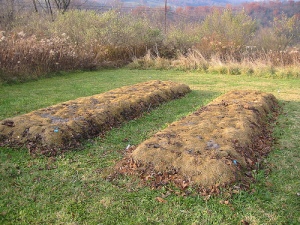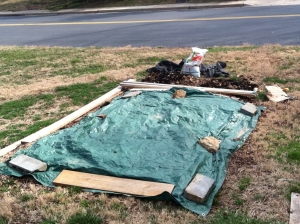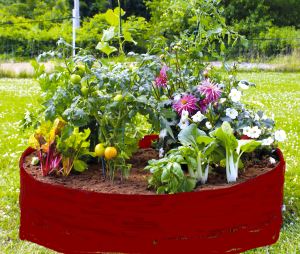No Dig – No Till gardening is possible
No dig gardening Is a breakthrough technique that is guaranteed to yield a beautiful, lush garden without hours & hours of backbreaking digging.
Turn in your tiller for a stack of old newspapers!
Replace your shovel with a layer of grass clippings!
No Dig Gardening is also known as sheet mulching or lasagna gardening, it’s a no-till gardening method that turns materials like table leftovers, straw, leaves, wood chips, grass clippings and newspapers into healthy compost.
 It uses up stuff that you would normally put out at the curb and say goodbye; it is turns into something valuable in which to grow.
It uses up stuff that you would normally put out at the curb and say goodbye; it is turns into something valuable in which to grow.
A gardener makes the layers just like a cook makes lasagna.
If you have a barren, sloped, stony, weedy, sandy, or clay compacted place where you look at aghast and wonder how you could ever get a garden going there?
We have an answer.
Why it works?
All organic matter is made up of substantial amounts of carbon (C) combined with lesser amounts of nitrogen (N). The balance of these two elements in an organism is called the carbon-to-nitrogen ratio (C:N ratio).
To make compost in the least amount of time, you must turn this material (pile) from the inside to the outside often, use correct ratio of carbon, nitrogen, and water. It is a lot of work.
You can produce sweet-smelling compost in as little as 30 days, if you maintain a C:N ratio somewhere around 25 to 30 parts carbon to 1 part nitrogen, by volume, turn the pile often and watch the water content.
If the C:N ratio is too high (excess carbon), decomposition slows down.
If the C:N ratio is too low (excess nitrogen) you will end up with a stinky pile. This ratio is determined by volume, not weight.
For our purposes, the materials containing large amounts of carbon are considered “browns,” and materials containing large amounts of nitrogen are considered “greens.”
Carbon (C) to Nitrogen (N) Ratio
| Browns | C:N | Greens | C:N | |
| Ashes, wood | 25:1 | Alfalfa | 12:1 | |
| Cardboard, shredded | 350:1 | Clover | 23:1 | |
| Corn stalks | 75:1 | Coffee grounds | 20:1 | |
| Fruit waste | 35:1 | Food waste | 20:1 | |
| Leaves | 60:1 | Garden waste | 30:1 | |
| Newspaper, shredded | 175:1 | Grass clippings | 20:1 | |
| Peanut shells | 35:1 | Hay | 25:1 | |
| Pine needles | 80:1 | Manures | 15:1 | |
| Sawdust | 325:1 | Washed Seaweed | 19:1 | |
| Straw | 75:1 | Veg scraps | 25:1 | |
| Wood chips | 400:1 | Weeds | 30:1 | |
| Pine/Douglas Fir Bark | 491:1 | Oak leaves | 26:1 | |
| Alder Sawdust | 134:1 |
For a complete list of C:N ratio http://compost.css.cornell.edu/OnFarmHandbook/apa.taba1.html
Lasagna Method
With the Lasagna method, there is no weighing or measuring anything. We use less time with no digging. This method uses alternating layer of brown and green organic material. It will take longer to make compost, but there is no digging.
“Compost does Happen in Time”
You can start with a “brown” or “green” layer. Start by spreading 2 – 3 inches of a mix of high-nitrogen “green” material on the ground such as vegetable peelings, grass clippings, fresh manure, coffee grounds or plant cuttings without seeds. Then top that with 3 – 4 inches of a mix of high-carbon “brown” material such as leaves, straw, black-and-white newspaper, cardboard, sawdust, tea bags or wood ash.
Alternate the green and brown material. The pile could grow 2 to 3 feet high but continually shrinks as it turns into compost. It doesn’t matter if green or brown material makes up the last layer. Soak each layer well with water.
No Dig Garden can start at any time of year; however, it does take time. If you start your bed in early summer, you will have to wait until the fall to plant.
 You don’t need to turn the pile. You can cover the pile with a plastic cover to protect but do not cover it too tightly.
You don’t need to turn the pile. You can cover the pile with a plastic cover to protect but do not cover it too tightly.
When it comes time to take off the plastic in the spring, you have great new compost and ready to plant in.
This method of composting is slow. It takes anywhere from several months to a year for finished compost in this form.
Eventually, in time, all the organic material will turn to compost and will provide a great home for your plants.
If you do it in winter, it will be compost by summer and your bed could look like this one.
Click Here to email for more information or to be added to our mailing list or call 541-996-3671.



You must be logged in to post a comment.